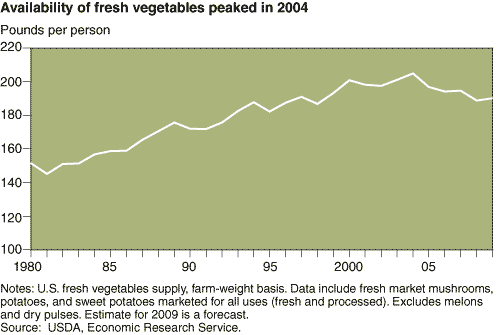Birth Year Affects Demand for At-Home Fresh Vegetables
- by Hayden Stewart and Gary Lucier
- 3/1/2010
Younger and older Americans eat differently. A 30-something may heat frozen entrées in the microwave or grab takeout meals from a restaurant, whereas a 60-something may prepare home-cooked meals from basic ingredients. One key difference between the generations lies in their demand for at-home fresh vegetables, those purchased in grocery stores and other retail outlets.
Households headed by older generations spend more money per person on at-home fresh vegetables than their younger counterparts. However, as younger people age, are they likely to adopt their parents’ behaviors? Not entirely, according to ERS research. As they age, younger people will spend more on at-home fresh vegetables, but when they reach their parents’ current age, they will still spend less than their parents do now.
Using 1982-2003 data, ERS explored how a household’s expenditures on fresh vegetables varied by the head of household’s birth year, age, income, and other demand determinants. Each generation starts its adult years with different base levels of demand for at-home fresh vegetables. The generations continue to spend different amounts at each subsequent age point, with the youngest spending the least. After accounting for other demand determinants, ERS found that households headed by a person born in 1960 spent 21 cents less per person weekly for at-home fresh vegetables than those headed by someone born in 1950, and 66 cents less than if the household head was born in 1930.
Changes over the decades in how Americans purchase and prepare foods may have a significant effect on expenditures. Fresh vegetables are often a basic ingredient in home-cooked meals. Traditional varieties also tend to require some amount of peeling, chopping, and cutting. Younger generations may make fewer home-cooked meals from basic ingredients, buying more convenience foods instead.
Spending less money for fresh vegetables at grocery stores suggests that younger generations are buying smaller quantities, or purchasing less expensive vegetables, or both. If younger Americans are consuming less at-home fresh vegetables, the quality of their diets may suffer unless they consume more vegetables in prepared foods or when eating out.
This article is drawn from:
- Stewart, H. & Lucier, G. (2009). Vegetables and Melons Outlook: August 2009. U.S. Department of Agriculture, Economic Research Service. VGS-333-01.


